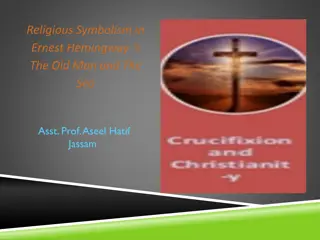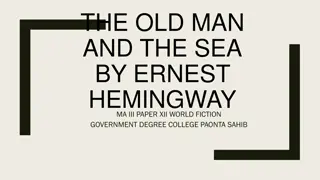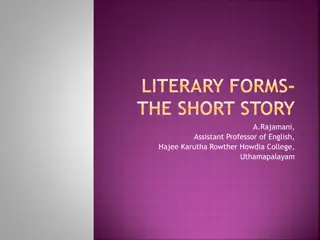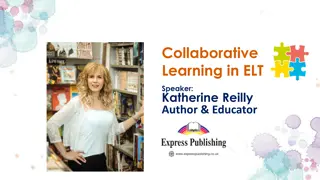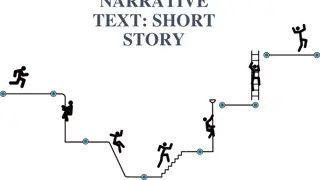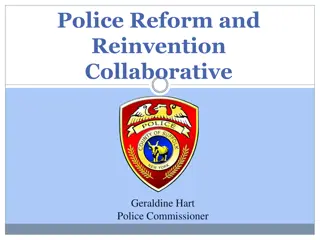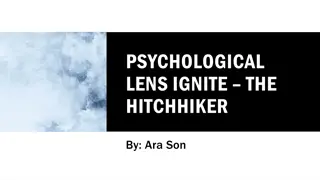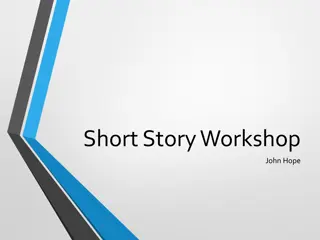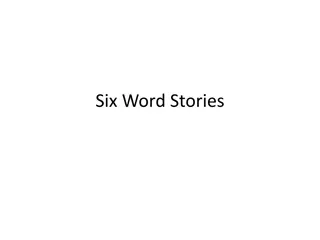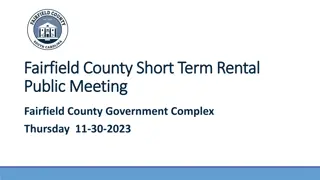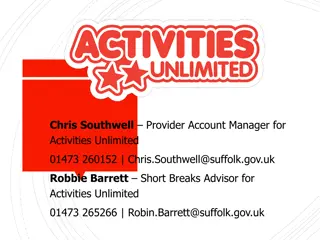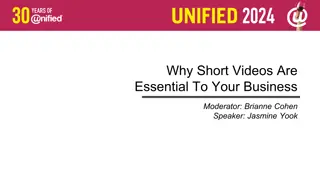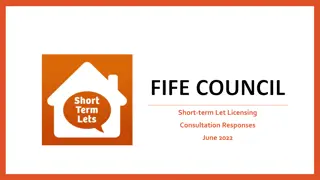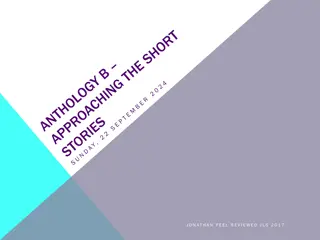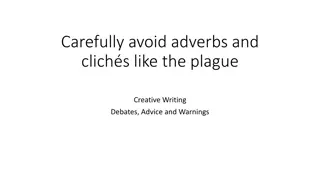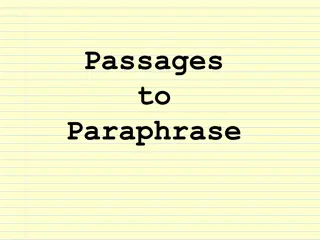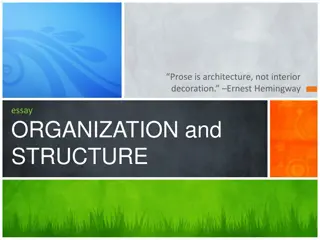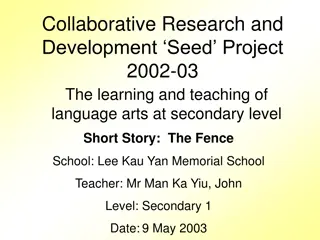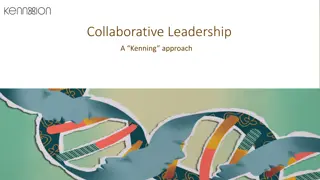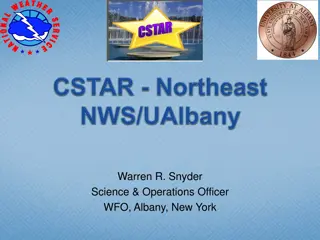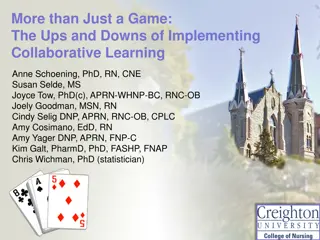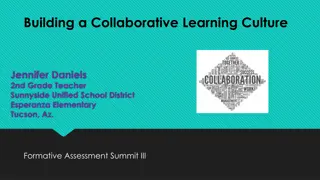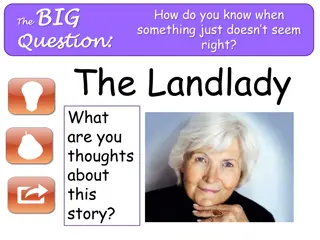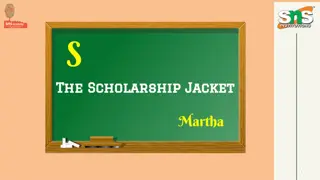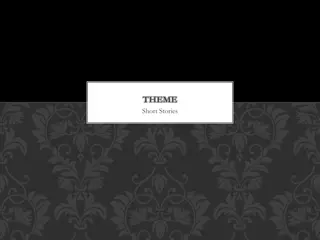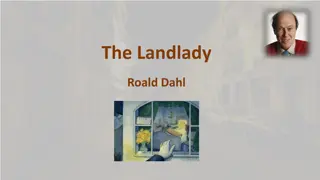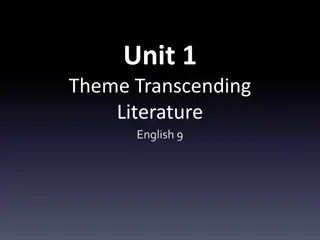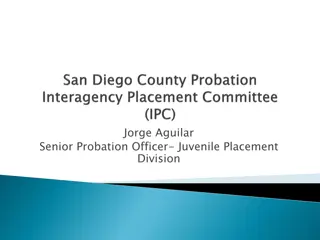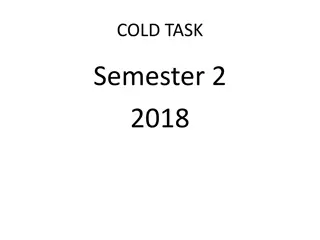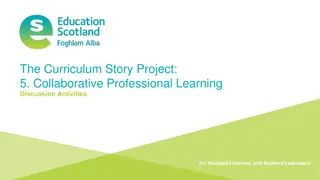Collaborative Analysis of a Short Story by Hemingway
Partner with classmates to analyze a one-line Hemingway story about selling baby shoes. Discuss the possible relationships, emotions, and commercialism implied in the ad-like narrative. Reflect on the group discussion process and share learnings. Consider the writer's purpose and audience in analyzing stories by William Carlos Williams.
Download Presentation

Please find below an Image/Link to download the presentation.
The content on the website is provided AS IS for your information and personal use only. It may not be sold, licensed, or shared on other websites without obtaining consent from the author. Download presentation by click this link. If you encounter any issues during the download, it is possible that the publisher has removed the file from their server.
E N D
Presentation Transcript
Practicing the Genre: Analyzing a Story Collaboratively Partner with one or two classmates and discuss the one-line Hemingway story on page 440. Refer to the following guidelines while interpreting this story. Ch. 10 Analyzing Stories
Part One Discuss the story, using these questions to get started: It looks like an ad, but who would try to sell baby shoes, and why? What is the likely relationship between the person trying to sell the shoes and the baby for whom the shoes were originally bought? Who could be a potential buyer for the shoes? Where and when was the ad written? (In a country where there are land mines? In a time of severe economic depression?) Why is the story so short? What could the brevity say about emotion? What could the fact that the story is written in the form of an advertisement suggest about commercialism?
Part Two Reflect on the process of analyzing the story in your group: Before you began, what were your expectations of how the group would work together? Did you think your group should/would agree on the right answer? Did you expect significant disagreement? What happened once you began to discuss the story? How did the discussion affect your attitude about the story or about the process of analyzing stories? What, if anything, did you learn?
Guide to Reading: Analyzing Essays That Analyze Stories Read the selections in this chapter and consider how students analyzed The Use of Force by William Carlos Williams: Iris Lee interprets the story through the lens of the doctor s Hippocratic Oath to do no harm (pp. 446-49). Isabella Wright interprets the story as a breaking away from convention (pp. 450-52).
Analyzing Essays That Analyze Stories: Determine the writer s purpose. What seems to be the writer s main purpose? to illuminate the story? to change or expand the way readers understand the story? to impress readers with the writer s insight and close reading?
Analyzing Essays That Analyze Stories: Determine the writer s audience. What does the writer assume about the audience? The analyses in this chapter were written by students; their primary reader was their instructor. The instructor read the story and was knowledgeable about its context. In cases such as these, plot summaries and recitals of well-known facts are not necessary.
Analyzing Essays That Analyze Stories: Assess the genre s basic features. A Clear, Arguable Thesis A Well-Supported Argument A Clear, Logical Organization
A Clear, Arguable Thesis Read first to find the thesis statement. A good thesis statement: asserts the main idea or claim; is arguable, not a simple statement of fact or an obvious conclusion; is appropriately qualified, not overgeneralized or exaggerated; is clearly stated, not vague or ambiguous. A thesis is often part of an introductory paragraph. Introductions provide information about the story, such as title, author, and background information. Introduce key terms in your opening paragraph(s). Introductions provide opportunities to forecast your argument.
A Well-Supported Argument Consider how the writer provides support for the argument. Essays that analyze stories present new ideas that readers may disagree with, so your argument must include: reasons the supporting ideas or points that develop the essay s thesis or main claim; evidence or examples from the story; explanations or analyses showing how the examples support the argument. Quoting evidence from the text is the most important method of providing support for essays that analyze short stories. Quoting on its own is not enough, however. Writers must then analyze the quote to explain how its connotations, figurative use in images and metaphors, and its symbolism enrich the story. Example: _______ [type of evidence from text], such as _______ and _______ [quotations] demonstrates/shows _______ [analysis]. Evidence can also be presented by summarizing or paraphrasing. When X says/does _______ [summary/paraphrase] readers can readily see _______ [analysis].
A Clear, Logical Organization To make the argument easy to follow, writers include: Topic sentences introducing paragraphs or groups of paragraphs (often using key terms from the thesis statement) Key terms as a way of forecasting the development of the argument; they are repeated strategically throughout the essay Clear transitional words and phrases (such as although, in addition, and at the story s beginning ) Topic sentences are typically found near the beginning of a paragraph and repeat key terms from the thesis.
Guide to Writing: The Writing Assignment Choose a story and compose an essay that analyzes one of more of its aspects. Make your analysis interesting to readers and convince them that it contributes to the conversation about the story. Include quotations and examples to support your ideas.
Starting Points: Analyzing Stories Basic Feature Ask Yourself . . . How can I find a good story to write about? Take a Look at . . . Find a story to write about. (p. 456) Analyze the story. (pp. 457 60) How do I decide on a main idea and develop a thesis? Determine the writer s purpose and audience. (p. 442) Assess the genre s basic features: A clear, arguable thesis. (pp. 443 44) A Clear, Arguable Thesis: Getting Beneath the Surface (p. 452) Analyze the story. (pp. 457 60) Formulate a working thesis. (pp. 461 62) A Troubleshooting Guide: A Clear, Arguable Thesis (p. 468) A Clear, Arguable Thesis
Starting Points: Analyzing Stories Ask Yourself . . . Take a Look at . . . Basic Feature Assess the genre s basic features: A well-supported argument. (pp. 444 45) A Well-Supported Argument: Pairing Textual Evidence with Analysis (p. 453) Analyze the story. (pp. 457 60) Formulate a working thesis. (pp. 461 62) Provide support for your argument. (pp. 463 64) To build on your support, consider doing outside research. (p. 464) A Troubleshooting Guide: A Well-Supported Argument (p. 469) Assess the genre s basic features: A clear, logical organization. (pp. 445 46) A Clear, Logical Organization: Coordinating Key Words and Topic Sentences (p. 453) Create an outline that will organize your argument effectively. (pp. 464 65) Write the opening sentences. (p. 465) Draft your analysis. (p. 466) A Troubleshooting Guide: A Clear, Logical Organization (p. 469) How do I support my ideas? A Well- Supported Argument How should I organize my argument so that my audience can follow it easily? A Clear, Logical Organization
Guide to Writing: Writing a Draft: Invention, Research, Planning, and Composing The following activities will help you choose a story, perform analyses, and develop and argue a position on the story. You can use your responses to the following activities in your rough draft.
Find a story to write about. The story you choose must: deal with a culturally, politically, or historically significant theme; surprise or puzzle you with apparent contradictions; lead you to wonder about the backstory or context; raise questions about characters motivations, relationships, or development; use conventional story motifs, settings, or other features in unconventional ways; resonate emotionally. Browse one of the following sites to find a short story: American Literature short story library (americanliterature.com) Classic Short Stories (classicshorts.com) Classic Reader: Short Stories (classicreader.com/browse/6) Short Story Archive (shortstoryarchive.com)
Analyze the story. Consult the following suggestions for advice on exploring different aspects of your story. WHAT ELEMENTS COULD I ANALYZE, AND WHY? Character You want to know why a character acts in a particular way how gender or ethnicity affects relationships whether a character changes or grows whether we should approve of a character s actions or accept his or her justifications WHAT APPROACH MIGHT I TAKE? Psychological WHAT SHOULD I ASK MYSELF? Does the character change/learn anything in the course of the story? How does the character relate to other characters? For instance, how does he or she deal with intimacy, commitment, and responsibility? Does the character seem depressed, manic, abusive, fearful, egotistical, or paranoid? Does any other character seem to represent the character s double or opposite?
Present the subject to your readers. WHAT ELEMENTS COULD I ANALYZE, AND WHY? WHAT APPROACH MIGHT I TAKE? Ethical or moral WHAT SHOULD I ASK MYSELF? What are the character s virtues and/or vices? What influences your judgment of the character? Something in the story (such as what the narrator or another character says)? Something you bring to the story (your views of right and wrong, based on your family upbringing or religious teachings)? Something else? Do any of the other characters have different moral values that could be compared or contrasted to the character s values?
Present the subject to your readers. WHAT ELEMENTS COULD I ANALYZE, AND WHY? WHAT APPROACH MIGHT I TAKE? Social or cultural WHAT SHOULD I ASK MYSELF? How does the character fit into and appear to be defined by society in terms of race, ethnicity, socioeconomic class, sexual orientation, age, or gender? Who in the story exercises power over whom? What causes the difference in power? What are the effects of this difference? Does the balance of power change during the story?
Present the subject to your readers. WHAT ELEMENTS COULD I ANALYZE, AND WHY? Setting You want to know how much time and place matter what the description of the setting symbolizes how the setting affects characters WHAT APPROACH MIGHT I TAKE? In relation to the mood, characters, or actions WHAT SHOULD I ASK MYSELF? How does the setting affect the mood? For example, does it create feelings of suspense or foreboding? Are there any cause-effect connections between the setting and what characters are doing, thinking, or feeling? Historical or cultural How does the historical period or cultural context in which the story is set affect what happens and does not happen? How might the story s meaning be different if the historical time or cultural situation were changed?
Present the subject to your readers. WHAT ELEMENTS COULD I ANALYZE, AND WHY? WHAT APPROACH MIGHT I TAKE? Metaphoric or symbolic WHAT SHOULD I ASK MYSELF? Assuming that the setting is a projection of the thoughts and feelings of the narrator, what does the setting tell you about the narrator s state of mind? Assuming that the setting symbolizes the social relations among characters in the story, what does the setting tell you about these relationships? Assuming that the setting stands for something outside the characters control (such as nature, God, or some aspect of society), what does the setting tell you about the pressures and rules under which the characters function?
Present the subject to your readers. WHAT ELEMENTS COULD I ANALYZE, AND WHY? Plot Structure You want to know what the ending means whether there is a turning point in the story how a subplot relates to the main plot WHAT APPROACH MIGHT I TAKE? As realistic (resembling real- life experience) WHAT SHOULD I ASK MYSELF? After marking where each new stage of the story begins, how can the sequence of scenes or events be understood? In what ways do subplots mirror, undercut, or comment on the main plot? As surrealistic (having symbolic rather than literal meaning) Thinking of the story as a series of images (more like a collage or a dream than a realistic portrayal of actual events), what meanings do you find in the arrangement of these images?
Present the subject to your readers. WHAT ELEMENTS COULD I ANALYZE, AND WHY? Point of View You want to know whether the narrator can be believed whose values and interests are represented how readers sympathies are manipulated WHAT APPROACH MIGHT I TAKE? In terms of what the narrator actually sees WHAT SHOULD I ASK MYSELF? Is the narrator a character in the story or an all-knowing, disembodied voice who knows what every character thinks, feels, and does? What important insights or ideas does the narrator have? How do factors such as the narrator s gender, age, and ethnicity influence what he or she notices as important? Are there things that the narrator is not able to see or that he or she distorts for example, certain truths about himself or herself, about other characters, or about what happens in the story?
Present the subject to your readers. WHAT ELEMENTS COULD I ANALYZE, AND WHY? WHAT APPROACH MIGHT I TAKE? In terms of how the narrator represents what he or she sees WHAT SHOULD I ASK MYSELF? How would you characterize the narrator s tone at various points in the story? For example, is the tone satirical, celebratory, angry, bitter, or optimistic? What about the narrator (or about the situation) might account for each tone you identify? What special agenda or motive might have led the narrator to this particular way of describing characters and scenes or telling the story?
Present the subject to your readers. WHAT ELEMENTS COULD I ANALYZE, AND WHY? Literary Motif or Theme You want to know whether the story is about a break with social conventions, the initiation into adulthood, or some other common literary motif what the story says about war, poverty, love, alienation, or some other general theme how the story illuminates a historical or current issue WHAT APPROACH MIGHT I TAKE? In terms of a traditional story motif (or an ironic reversal of the tradition) WHAT SHOULD I ASK MYSELF? Could you analyze the text as . . . an initiation (or coming-of-age or rite-of-passage) story? . . . a quest (for love, truth, fame, fortune, or salvation of oneself or the community)? . . . a story about a character s disillusionment or fall from innocence? . . . a story about family or surrogate families? . . . a story about storytelling (or some other art) or becoming a writer or an artist? Might you focus on the theme of . . . the American dream? . . . the social construction of femininity or masculinity? . . . race relations in America? . . . alienation? . . . the urban or suburban experience? In terms of a common literary theme
Analyze the story. Consult the following lists for help generating ideas about your story. HOW CAN I GENERATE IDEAS BY MOVING FROM SPECIFIC DETAILS TO GENERAL IDEAS? 1. Select two or three quotations, and write several sentences answering this question: What idea or ideas does each quotation suggest, and what in the quotation makes you think so? 2. Write a paragraph analyzing one or more patterns you found in the story. Here are a few patterns to help you get started: Imagery (for example, the militaristic images in The Use of Force that Lee analyzes) Characters as contrasts (for example, differences between the parents and the doctor in The Use of Force that Wright discusses) Events that echo or reverse one another (for example, the doctor s fury echoes the young girl s)
Analyze the story. Consult the following lists for help generating ideas about your story. HOW CAN I GENERATE IDEAS BY MOVING FROM GENERAL IDEAS TO SPECIFIC DETAILS? 1. List ideas you thought of as you analyzed the story, without worrying about how these ideas relate to one another or whether they are contradictory. For example, here are two of Isabella Wright s ideas about the doctor in The Use of Force (see A Writer at Work, pp. 472 74). He has no time for the social conventions upheld by the parents. His break with social conventions feels freeing maybe even transformative. 2. Review the story to find quotations or other details you could use to illustrate your ideas. 3. Write for a few minutes about your most interesting ideas and how they connect. For example, in exploring her ideas about The Use of Force, Wright connected ideas about breaking social conventions to develop her main claim about the transformative power of disobeying the rules of social behavior.
Test Your Choice Choosing a Topic Get together with two or three students who have read your story, and offer responses to one another s ideas. Take turns presenting your subject and listening to others descriptions.
Formulate a working thesis. Refer to the following activity for help drafting a working thesis statement. HOW CAN I FORMULATE AN ARGUABLE THESIS? Write for ten minutes about your most promising ideas. After writing, read what you have written and see if you can find one main idea or claim that can serve as the thesis for your essay. Focus your exploratory writing on questions like these: How can readers understand a character s internal conflict or apparent change? How is the story s theme reflected in the way the story is told, the way the setting is described, how characters relate to one another, or some other aspect of the story? How does the language used to describe the setting or the characters actions illuminate such things as the main character s internal conflict, the relationship between characters, or the theme? (For example, the doctor-patient struggle described in The Use of Force forms the basis of Iris Lee s argument that the story warns readers against blindly trusting doctors.) What does the trajectory of the story (the plot structure) say about the characters or the culture? (For example, Isabella Wright s analysis of the increasing tension between repression and expression, social conventions and human willfulness, underlies her argument about the value of breaking with these conventions.)
Formulate a working thesis. HOW CAN I FORMULATE AN ARGUABLE THESIS? CONT D Reread the story with one of the following questions (or a question of your own) in mind, underlining passages or taking notes as you read: How do my ideas about the story form links in a chain leading to some general conclusion? For example, Wright links two ideas: (1) pressure to adhere to social conventions and (2) reasons for breaking with these conventions. She is not simply retelling the story; she is stating her ideas about what happens in the story. How can I present my ideas as a response to a question either a question my instructor asked or one I composed myself? For example, in their essays, Lee and Wright responded to the first question we pose in the Analyze & Write section for The Use of Force (p. 484). What, if anything, does the story say about what may be universally true about people and society versus what may result from specific historical, economic, or cultural conditions? About what is usually considered normal versus what is considered abnormal? About how some groups exert power while others may be oppressed or subversive?
Formulate a working thesis. HOW CAN I FORMULATE AN ARGUABLE THESIS? CONT D Now reread your notes. Do they suggest one MAINIDEAor CLAIM that can serve as the thesis for your essay? Use the sentence strategies that follow as a jumping-off point; put your thesis into your own words when you revise, or use your own words and sentence patterns now: Many readers of X point to __________ [state feature(s) of the story], but an important aspect of the story that is often overlooked is __________. A common/superficial reading of X [name story or character] is that __________ [common conclusion], but in fact __________ [your own conclusion]. Through the actions of X [name character], we are led to this surprising conclusion: __________. Through the events unfolded in X [name story], readers are led to this disturbing conclusion: __________.
Provide support for your argument. Look back on the ideas you ve generated and ask yourself: How can I present my ideas as reasons supporting my central claim, the essay s thesis? Have I remembered to include my own analysis in the support instead of just retelling the story through quotation, paraphrase, or summary? HOW CAN I INTEGRATE EVIDENCE FROM THE STORY? As noted earlier, to provide support for a short story analysis, writers may quote, PARAPHRASE, or SUMMARIZE parts of the story. However, this evidence should be offered in the service of a thoughtful examination of the story and go beyond a simple repetition of description, dialogue, and so on.
Provide support for your argument. HOW CAN I INTEGRATE EVIDENCE FROM THE STORY? CONT D To effectively integrate material from a story, try these strategies: Use short quotations frequently to support your ANALYSIS. Brief quotations are not in themselves superior to sentence-length and longer quotations, but they allow you to stay focused on your own argument while bringing in key information or vivid details from the story. Look at these examples from the student essays in this chapter: To the contrary, from the beginning, he and, through him, readers sees the little girl as unusually attractive and strong, with magnificent blonde hair (482). This description of her seems almost angelic. (Wright, par. 5) Later, the mother reassures the child that the doctor is a nice man and won t hurt you, though she can base those assertions only on what little she knows of him: his occupation (483). (Lee, par. 2)
Provide support for your argument. HOW CAN I INTEGRATE EVIDENCE FROM THE STORY? CONT D Comment directly on what you have QUOTED, PARAPHRASED, or SUMMARIZED so that readers will understand the relevance of this material to your ANALYSIS. These comments should connect the quotation, paraphrase, or summary to the idea you are trying to support. One good strategy is to refer to quotations or paraphrases with this, these, or they statements, which are shown in green underscore in the following examples: After quoting the doctor s violent thoughts about the girl, Lee comments, Although these statements are arguably exaggerated or hyperbolic, they, like the metaphors of war, imply a tendency to do harm that goes directly against the narrator s duty as a doctor (Lee, par. 4). After summarizing the doctor s struggle with the girl, Wright notes, This conflict might be interpreted as a process of reverse socialization or reverse civilization, a transformation that, surprisingly, the story presents as a potentially positive change (Wright, par. 5).
Provide support for your argument. HOW CAN I INTEGRATE EVIDENCE FROM THE STORY? CONT D Another good strategy is to repeat key nouns from quotations, paraphrases, or summaries in your analysis. These nouns appear in green, underscored type in the following examples: After quoting part of the story that refers to the doctor smiling in his best professional manner, Lee explains that, in using the phrase professional manner, the narrator admits his actions are not sincere but a calculated professional performance (Lee, par. 3). After quoting and paraphrasing information about the parents politeness to the doctor, Wright observes, In a story where politeness is made to seem absurd, the doctor s tactless words and his inappropriate use of force actually have the potential to be improvements on his character (Wright, par. 6).
To build on your support, consider doing outside research. While many analyses rely solely on a close reading of the short story, others include information garnered from research on the author and the topic. Here are some suggestions on gathering background information about the author, his/her works, and others responses to them: Do a Google search, using keywords relevant to your analysis. To see what others have said about an author s work, conduct a search using a specialized periodical database, such as the MLA International Bibliography.
Create an outline that will organize your argument effectively. Refer to the following outline that Iris Lee may have used to organize her argument: I. The story performs a valuable service because, through the doctor s actions, readers see that it s unwise to trust members of his profession blindly. A. Although he displays his best professional manner, the doctor does so only because he knows it will encourage the family s deference to him despite his rude and rough behavior. B. The doctor shows his untrustworthiness because he seems more interested in harming the girl than healing her. II. Readers who see the doctor purely as a bad person are wrong because the author presents two sides of him. A. The doctor-as-actor deserves our scorn because he is capable of brutality under the guise of professionalism. B. The doctor-as-narrator deserves our thanks because he depicts the crimes of the doctor-as-actor, warning readers about the dangers of placing too much trust in medical professionals.
Write the opening sentences. While writing your introduction, avoid creating a funnel paragraph A funnel paragraph begins with a broad generalization and culminates in the essay s thesis. An analysis that begins with a broad generalization does not usually interest readers. Instead, begin by presenting your ideas about the story.
Draft your analysis. By this point, you have done a lot of writing to: come up with ideas for your short story analysis; draft an arguable thesis; provide support for your argument; organize your ideas to present them logically to readers. Tie together all of this material and create your draft.
Guide to Writing: Evaluating the Draft: Using Peer Review In a peer review session, exchange drafts with classmates and give each other a critical reading. A good critical reading will: Let the writer know how well the reader understands the analysis. 2. Praise what works best. 3. Indicate where the draft could be improved and make suggestions on how to improve it. 1.
A Peer Review Guide Ask Yourself . . . Summarize/Praise/Critique Basic Feature How well does the writer present the thesis? Summarize: Tell the writer what you understand the essay s thesis to be and what its key terms are. Praise: Tell the writer what seems most interesting to you about his or her main claim about the story, whether you agree with it or not. Critique: If you cannot find the thesis statement or cannot identify the key terms, let the writer know. Evaluate the thesis statement on the basis of whether A Clear, Arguable Thesis it makes an interesting and arguable assertion (rather than making a statement of fact or an obvious point) it is clear and precise (neither ambiguous nor vague) it is appropriately qualified (neither overgeneralized nor exaggerated)
A Peer Review Guide Ask Yourself . . . Summarize/Praise/Critique Basic Feature How well does the writer develop and support the argument? Summarize: Underline the thesis statement and the major support for it. (Often, the major support appears in the topic sentences of paragraphs.) Praise: Give an example in the essay where support for a reason is presented especially effectively for instance, note where brief quotations (words and short phrases), a longer quotation, or summaries of particular events are introduced and explained in a way that clearly illustrates a particular point that is being argued. A Well- Supported Argument Critique: Tell the writer where the connection between a reason and its support seems vague, where too much plot is being relayed with no apparent point, or where a quotation is left to speak for itself without explanation. Let the writer know if any part of the argument seems to be undeveloped or does not support the thesis.
A Peer Review Guide Ask Yourself . . . Summarize/Praise/Critique Basic Feature Has the writer clearly and logically organized the argument? Summarize: Underline the sentence(s) in which the writer forecasts supporting reasons, and circle transitions or repeated key words and phrases. Praise: Give an example of something that makes the essay especially easy to read where, for example, the key terms introduced in the thesis recur throughout the essay in topic sentences and elsewhere, or where transitions are used logically. A Clear, Logical Organization Critique: Tell the writer where readability could be improved. For example, point to places where key terms could be added or where a topic sentence could be made clearer, indicate where the use of transitions might be improved, or note where transitions are lacking and could be added.
Guide to Writing: Improving the Draft: Revising, Editing, and Proofreading Reflect on what you have written thus far: Review critical reading comments from your classmates, instructor, or writing center tutor. What are your readers getting at? What else should you consider about your invention writing? Review your draft. What can you do to present your argument more compellingly?
A Troubleshooting Guide Basic Feature Problem My thesis is unclear or overgeneralized. Options Add more explanation. Refer to the story specifically. Add qualifying words like some or usually. A Clear, Arguable Thesis My thesis is not arguable or interesting. Respond to a question or class discussion. Summarize an alternative argument. Try additional suggestions for analysis from the Ways In boxes on pp. 457 60.
A Troubleshooting Guide Basic Feature Problem My argument seems superficial or thin. Options Develop your ideas by connecting them. Link your ideas to make a chain of reasoning. Connect to a literary motif or theme. Add textual evidence by quoting, paraphrasing, or summarizing important passages. Focus on the writer s choice of words, explaining how particular word choices support your ideas. Consider using other kinds of support, such as information about the story s historical or cultural context. A Well- Supported Argument
A Troubleshooting Guide Basic Feature Problem The connection between a reason and its support seems vague. Options Explain why the support illustrates the point you are making. Explain what the quoted words imply their connotative (cultural or emotional) associations as well as their denotative (literal or dictionary) meanings. Introduce quotations, and follow them with some analysis or explanation. Explain more fully and clearly how your reasons relate logically to one another as well as to your thesis. Fill in the gaps. Use contradictions or gaps to extend or complicate your argument. Repeat key terms from the thesis and other introductory text. Provide explicit topic sentences. Add logical transitions. A Well- Supported Argument My essay is hard to follow. A Clear, Logical Organization
Edit and proofread your draft. Use Parallel Structure Using Ellipsis Marks Correctly The Problem: Failing to use ellipsis marks to indicate omission of material misrepresents the quote. This is a serious breach of convention. The Solution: If you are using MLA style, follow the rules on p.471 of the text for guidance on how to use ellipsis marks correctly. The Problem: Items presented in a series must be presented using the same grammatical form. Mixing forms and tenses creates confusion. Example: The doctor s actions actually hurt rather than providing any benefit to a patient. The Solution: Fix verbs so that they are parallel with each other. This also emphasizes the contrast between the two ideas. Example: The doctor s actions actually hurt rather than help a patient.
Thinking Critically Reflecting on What You Have Learned Reflect on what you have learned about arguing for your analysis of a short story. Consider what you learned from the chapter s readings, your own writing, and any input from class discussions and collaboration.
Analyze & Write Write a blog post, a letter to your instructor or a classmate, or an e-mail message to a student who will take this course next term, using the writing prompt that seems most productive for you: Explain how your purpose and audience influenced one of your decisions as a writer, such as how you chose the suggestions for analysis you used, the key words you used in presenting your thesis, or the quotations you chose to support your argument. Discuss what you learned about yourself as a writer in the process of writing this essay. For example, what part of the process did you find most challenging? Did you try anything new, like getting a critical reading of your draft or summarizing an alternative argument to improve your thesis? If so, would you do it again? Choose one of the readings in this chapter, and explain how it influenced your essay. Be sure to cite specific examples from your essay and the reading. If you got good advice from a critical reader, explain exactly how the person helped you perhaps by questioning the way you stated your thesis or how you explained one of your reasons.
Thinking Critically Reflecting on the Genre Genres like essays analyzing stories are specialized and, compared to position papers and other genres, are read and written by a small group of people with common interests. Students who are composing essays that appeal to these groups must learn the specialized vocabulary used in this type of writing as well as the critical approaches to analyzing stories.



